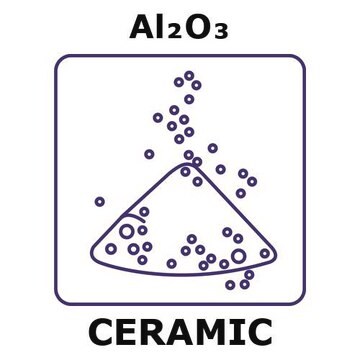702129
Aluminum oxide
nanoparticles, <50 nm particle size (DLS), 20 wt. % in isopropanol
Synonym(s):
Alumina
About This Item
Recommended Products
form
dispersion
nanoparticles
Quality Level
concentration
20 wt. % in isopropanol
particle size
<50 nm (DLS)
pH
8-10
density
0.79 g/cm3 at 25 °C
SMILES string
O=[Al]O[Al]=O
InChI
1S/2Al.3O
InChI key
TWNQGVIAIRXVLR-UHFFFAOYSA-N
Looking for similar products? Visit Product Comparison Guide
Related Categories
General description
Application
- Elemental analysis of levitated solid samples by microwave-assisted laser induced breakdown spectroscopy.: This study explores the application of aluminium oxide in enhancing the elemental analysis capabilities of laser induced breakdown spectroscopy, providing a novel approach for high precision chemical analysis in analytical chemistry (Alamri AM et al., 2024).
- An ab initio molecular dynamics investigation of the behaviour of amorphous substances in anodic aluminium oxide under electric field.: This research presents a molecular-level understanding of how amorphous substances behave within anodic aluminium oxide structures when subjected to an electric field, offering insights into the material′s stability and reactivity (An Z et al., 2024).
- Alternative nano-lithographic tools for shell-isolated nanoparticle enhanced Raman spectroscopy substrates.: The article discusses the utilization of aluminium oxide in the development of advanced nano-lithographic tools, significantly enhancing the performance of Raman spectroscopy for chemical detection and analysis (Srivastava K et al., 2024).
- Unexpected early loosening of rectangular straight femoral Zweymüller stems with an alumina-reduced surface after total hip arthroplasty-a prospective, double-blind, randomized controlled trial.: This study examines the clinical implications of using aluminium oxide in prosthetic implants, specifically its effect on the longevity and stability of femoral stems in hip arthroplasty (Moret CS et al., 2024).
- Green Synthesis of Aluminum Oxide Nanoparticles Using Clerodendrum phlomidis and Their Antibacterial, Anti-inflammatory, and Antioxidant Activities.: Investigates the biogenic synthesis of aluminium oxide nanoparticles, highlighting their potential in biomedical applications due to their antibacterial, anti-inflammatory, and antioxidant properties (Thanaraj S et al., 2024).
Signal Word
Danger
Hazard Statements
Precautionary Statements
Hazard Classifications
Eye Irrit. 2 - Flam. Liq. 2 - STOT SE 3
Target Organs
Central nervous system
Storage Class Code
3 - Flammable liquids
WGK
WGK 1
Flash Point(F)
53.6 °F - closed cup
Flash Point(C)
12 °C - closed cup
Personal Protective Equipment
Choose from one of the most recent versions:
Already Own This Product?
Find documentation for the products that you have recently purchased in the Document Library.
Customers Also Viewed
Articles
Hydrogen is one of the most important resources in providing food, fuel, and chemical products for our everyday life. Sustainable catalytic hydrogen production from bioethanol has gained significant attention in recent years due to globally diminishing fossil fuel supplies, which have necessitated the search for new chemical feedstocks.
Among various ceramics, one-dimensional (1-D) piezoelectric ceramics have attracted significant scientific attention for use in energy harvesting.
Electronically, it behaves as a wide band gap (3.2 eV) semiconductor and exhibits memristor properties.2 Optically, TiO2 has high opacity with a very high refractive index3 (>2.4), and it exhibits strong absorbance in the UV range.
Advanced Inorganic Materials for Solid State Lighting
Global Trade Item Number
| SKU | GTIN |
|---|---|
| 702129-100G | 4061832820682 |
| 702129-500G | 4061832820699 |
Our team of scientists has experience in all areas of research including Life Science, Material Science, Chemical Synthesis, Chromatography, Analytical and many others.
Contact Technical Service





